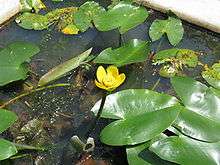Nuphar japonica
| Nuphar japonica | |
|---|---|
 | |
| Nuphar japonica (syn. N. subintegerrimum) Botanical Gardens Faculty of Science Osaka City University, Osaka, Japan | |
| Scientific classification | |
| Kingdom: | Plantae |
| Clade: | Angiosperms |
| Order: | Nymphaeales |
| Family: | Nymphaeaceae |
| Genus: | Nuphar |
| Section: | Nuphar sect. Nuphar |
| Species: | N. japonica |
| Binomial name | |
| Nuphar japonica DC., 1821 | |
| Synonyms | |
| |
Nuphar japonica, known as East Asian yellow water-lily,[1] is an aquatic plant species in the genus Nuphar found in Japan and the Korean Peninsula. It is endangered in Russia. The species was not accepted by The Plant List as of November 2013, which regarded it as an "unresolved name".[2]
Nuphar × saijoensis (Shimoda) Padgett is a hybrid between N. japonica and N. pumila.
N. japonica contains the alkaloids nupharidin, 1-desoxynupharidin, nupharamine, methyl and ethyl esters of nupharamine. The fruits also contains the alkaloids (0.06%) nupharine, beta-nupharidin, desoxynupharidin. In the rhizomes are found the steroid sitosterol, alkaloids acids, higher fatty acids (palmitic, oleic acid) and the ellagitanins nupharin A, B,[3] C, D, E and F.[4]
See also
- List of freshwater aquarium plant species
- List of the vascular plants in the Red Data Book of Russia
References
- ↑ English Names for Korean Native Plants (PDF). Pocheon: Korea National Arboretum. 2015. p. 549. ISBN 978-89-97450-98-5. Retrieved 4 January 2017 – via Korea Forest Service.
- ↑ "Nuphar japonica", The Plant List, retrieved 2013-11-14
- ↑ Tannins and Related Compounds. LXXV. : Isolation and Characterization of Novel Diastereoisomeric Ellagitannins, Nupharins A and B, and Their Homologues from Nuphar japonicum DC. Chemical & pharmaceutical bulletin, 25 January 1989, volume 37, issue 1, pages 129-134 (abstract)
- ↑ Tannins and Related Compounds. LXXIX. Isolation and Characterization of Novel Dimeric and Trimeric Hydrolyzable Tannins, Nuphrins C, D, E and F, from Nuphar japonicum DC. Chemical & pharmaceutical bulletin, 25 June 1989, volume 37, issue 7, pages 1735-1743 (abstract)
External links
| Wikimedia Commons has media related to Nuphar japonica. |
| Wikispecies has information related to: Nuphar japonica |